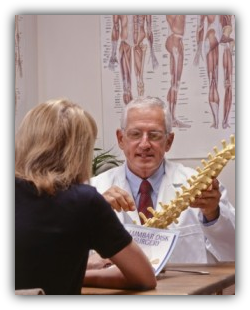


Chiropractic Terminology | A

A Chiropractic Doctor Explaining The Differences With Chiropractic Care And A Patients Proposed Medical Surgical Technique
The spoken word is one of the most important and cherished abilities that we have. If your chiropractor uses a word or phrase that you are unfamiliar with, don't be afraid to ask them to explain what it means. They will be happy to answer your questions because chiropractic doctors recognize, and place great importance, on creating an environment where you fully understand what is happening during your care and treatment.
EverybodiesChiropractor.com has compiled a comprehensive list of a variety of commonly used healthcare terms. We have made this list available for you to review so you can improve your understanding of chiropractic care and treatment. Make the most of this list and look up a specific term or look through the whole list if you have the time. By familiarizing yourself with basic chiropractic and healthcare terminology, you can establish an improved understanding of your prognosis and be able to ask essential questions during your consultation, examination and treatment.
If you have a question about any chiropractic or healthcare term or phrase, or would like a more in depth explanation of a particular term or subject that is not part of our list or within our web site, please feel free to Contact Us. We will be happy to help by providing you an explanation that will better help you understand your chiropractic care and treatment.


Abdomen: A part of the torso which lies between the diaphragm and the pelvis. It is commonly referred to as the stomach, belly or "tummy". Inside the abdominal cavity are a number of important organs, including the liver, pancreas, spleen and kidneys. A large part of the digestive tract is also found there, including the stomach and the small and large intestines.
Acupressure: The practice of applying pressure to specific meridian points on the body to relieve pain. Acupressure deals with all the aspects of a person as a whole: body, emotions, mind, and spirit as one, not as separate parts. It relaxes muscular tension and balances the vital life forces of the body.
Acupuncture: This is a method of encouraging the body to promote natural healing and to improve functioning. This is done by inserting needles and applying heat or electrical stimulation at very precise acupuncture points. Acupuncture and acupressure use the same points, but acupuncture uses needles, while acupressure uses the gentle but firm pressure of the hands. This treatment is highly effective at relieving tension, stress and pain.
Activator Adjusting Instrument: A spring loaded hand held instrument used by some chiropractors. This instrument utilizes a rapid pulse to tap the misaligned vertebrae back into place to restore normal spinal function.
Acute Pain: Acute pain refers to any specific, sharp pain that is of rapid onset or pain that results from a specific traumatic incident such as an injury. Acute pain is very isolated, comes on quickly, but often has a limited duration.
Acute Traumatic Injuries: Acute traumatic injuries usually involve a single blow from a single application of force such as a car accident. Examples include fracture, strain, sprain, abrasion and laceration. Acute pain from injury generally requires immediate attention, including first aid treatment with rest, ice, compression and elevation; or R.I.C.E.
Addiction: This is a condition where an individual actually craves and is addicted to consuming a particular substance, having a certain thing, or doing a particular activity. Addiction is a real disease with psychological, genetic and psychosocial aspects. People with an addiction do not have control over what they are doing, taking or using.
Adjustment: These are gentle forces introduced into the spine, typically by hand, with the intent of releasing a vertebral segment from its abnormal motion and/or position thereby reducing the vertebral subluxation.
Adrenal Glands: Your adrenal or suprarenal glands, are located on the top of each kidney. These glands produce hormones that you can't live without, including sex hormones and cortisol, which helps you respond to stress and has many other functions.
Adrenaline: This is a hormone produced by the adrenal glands in the body. The term "fight or flight" is often used to characterize the circumstances under which adrenaline is released into the body. When it is produced in the body it stimulates the heart-rate, contracts blood vessels, dilates air passages, stimulates metabolism, increases alertness and has a number of more minor effects. Adrenaline is naturally produced in high-stress or physically exhilarating situations.
Aerobic Exercises: This is any activity that raises the body's demand for oxygen, resulting in a temporary increase in rate of respiration and heart rate. It is a type of exercise that overloads the heart and lungs and causes them to work harder than at rest. The important idea behind aerobic exercise today, is to get up and get moving. Your heart and lungs become stronger and work more efficiently with regular aerobic exercise.
Afferent: This is the sensory division of peripheral nervous system composed of nerve fibers that relay impulses to the brain from sensory receptors located in the different parts of the body.
Alternative Medicine: A variety of therapeutic or preventive health care practices, such as chiropractic, homeopathy, naturopathy and herbal medicine, that take an all natural approach to health and healing. Unlike the medical model they utilize a variety of non-drug and non-surgical treatment.
Amphiarthrosis: A joint that permits slight mobility. Most amphiarthrosis joints are cartilaginous joints such as the vertebrae.
Amphiarthrosis: This is a joint that permits slight mobility. Most amphiarthrosis joints are cartilaginous joints such as the vertebrae.
Amino Acid: These acids are used in every cell of your body; they are used to build the proteins you need to survive. The human body can produce ten of its twenty needed amino acids on its own, but the other ten, which are called essential amino acids, can only be obtained by eating the right foods. The other ten are known as non-essential amino acids that the body can produce at will from amino acids already present. All the chemical reactions that occur in the body depend on amino acids and the proteins they build.
Anabolism: (a.k.a. Biosynthesis): This is the process by which our bodies make complex molecules and substances from less complex components. Anabolism leads to growth as molecules are produced from smaller components and are then added to our bones or muscles. Anabolism is a divergent process, which means that it produces a massive variety of different complex molecules from a relatively low number of simple substances.
Analgesics: These are drugs designed to relieve pain. The pain relief induced by analgesics occurs either by blocking pain signals going to the brain or by interfering with the brain's interpretation of the signals, without producing anesthesia or loss of consciousness. Aspirin is an example.
Anesthesiologist: A specialist who administers an anesthetic to a patient before they are treated. Their job is to block, prevent and provide pain relief during certain procedures.
Ankylosing Spondylitis: A form of chronic inflammation of the spine and the sacroiliac joints. It is also a systemic disease, meaning it can affect and spread to other tissues throughout the body. This condition leads to loss of mobility of the spine as it causes calcification of the spinal ligaments, resulting in a loss of movement. Imagine your feet being stuck in hardened cement.
Annulus Fibrosis: This is the tough outermost layer of the spinal intervertebral disc. It is a cartilage-like material formed by a series of rings that surround the nucleus pulpopus which is the soft center of the disc.
Antalgic Position: An abnormal position a patient places themselves in to avoid or minimize pain. It often indicates the evidence of medial or lateral disc protrusion.
Anterior: At or toward the front of the body. Anterior is the opposite of posterior.
Applied Kinesiology (a.k.a. AK): This is a diagnostic method created by George Goodheart, D.C. AK is a technique used to diagnose illness or choose treatment by testing muscles for strength and weakness. This method of testing muscle strength can detect disease, vitamin deficiency and other problems.
Arthritis: This refers to a group of more than one hundred rheumatic diseases and other conditions that can cause pain, stiffness and swelling in the joints. Any part of your body can become inflamed or painful from arthritis. It essentially is a gradual breakdown or deterioration of the joint spaces in your musculoskeletal system.
Articulation: An area where two bones are attached for the purpose of motion of body parts. An articulation, or joint, is usually formed of fibrous connective tissue and cartilage.
Assignment: An agreement between the healthcare provider and patient to waive payment until a claim is processed and paid by an insurance company. The assignment allows for payment then to be paid directly to the doctor.
Asthma: This is a chronic or long term lung disease that inflames and narrows the airways. It causes recurring periods of wheezing, chest tightness, shortness of breath and coughing. The coughing often occurs at night or early in the morning. Asthma affects people of all ages, but it most often starts during childhood.
Atlas: This is the name of the first bone of your neck or cervical spine. It is also known as C1 or cervical vertebra number one. This is the most freely moveable bone of the spine.
Atrophy: This is the partial or complete wasting away of a part of the body. When muscles atrophy, a decrease in mass occurs which then leads to muscle weakness, since the ability to exert force is directly related to a muscles mass.
Autonomic Nervous System: This is part of the peripheral nervous system and is often abbreviated ANS. There are two major components of the autonomic nervous system; the sympathetic and the parasympathetic systems. The ANS is responsible for regulating the involuntary functions in the body, such as digestion, metabolism, blood pressure, flight or fight responses; just to name a few. In most situations, we are unaware of the workings of the ANS because it functions in an involuntary, reflexive manner.





POSTED PROVISIONS


PARENT COMPANY
EVERYBODIES DIRECTORIES™
FAX NO: 1-314-480-7068

TOLL FREE: 1-866-515-9991
COPYRIGHT 2006 - 2012 EVERYBODIESCHIROPRACTOR.COM©. ALL RIGHTS RESERVED.










































































